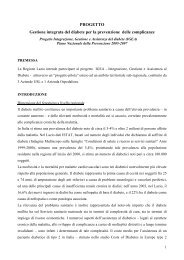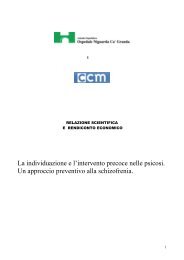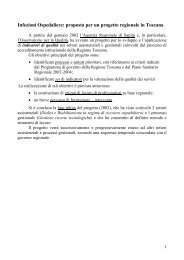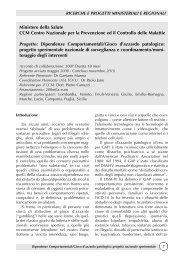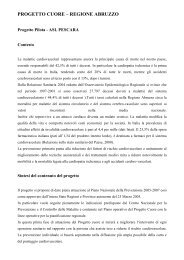Gaining health : analysis of policy development in European ...
Gaining health : analysis of policy development in European ...
Gaining health : analysis of policy development in European ...
Create successful ePaper yourself
Turn your PDF publications into a flip-book with our unique Google optimized e-Paper software.
stan and Uzbekistan. Serious concerns have been raised,<br />
however, about the quality and reliability <strong>of</strong> the data from<br />
all central Asian countries, especially <strong>in</strong>fant and maternal<br />
mortality rates.<br />
The remarkably high rate <strong>of</strong> excess mortality caused by<br />
chronic lower respiratory disease is expla<strong>in</strong>ed by a number<br />
<strong>of</strong> unfavourable environmental and behavioural factors,<br />
particularly the use <strong>of</strong> solid fuels and smok<strong>in</strong>g.<br />
As for many other countries <strong>in</strong> the WHO <strong>European</strong> Region,<br />
NCD are the ma<strong>in</strong> cause <strong>of</strong> death. Morbidity from <strong>in</strong>fectious<br />
diseases is relatively high, however, especially with<br />
respect to tuberculosis, malaria and, <strong>in</strong>creas<strong>in</strong>gly, sexually<br />
transmitted <strong>in</strong>fections.<br />
As to risk factors, tobacco and alcohol use place the greatest<br />
burden on males and high blood pressure and overweight<br />
on females. Between 2000 and 2005, alcohol consumption<br />
<strong>in</strong>creased by 28% and deaths caused by excessive<br />
dr<strong>in</strong>k<strong>in</strong>g rose by 130%.<br />
1.3. The ma<strong>in</strong> features <strong>of</strong> the <strong>health</strong> system<br />
In Kyrgyzstan, as <strong>in</strong> all countries emerg<strong>in</strong>g from the former<br />
USSR, the <strong>health</strong> care system was developed based on the<br />
strongly centralized Semaško model. The rights and responsibilities<br />
<strong>of</strong> the population <strong>in</strong> the field <strong>of</strong> <strong>health</strong> protection<br />
are secured <strong>in</strong> the Constitution <strong>of</strong> the Kyrgyz Republic<br />
and the Law on <strong>health</strong> protection <strong>of</strong> citizens <strong>of</strong> the Kyrgyz<br />
Republic.<br />
The Government adopts <strong>health</strong> <strong>policy</strong> follow<strong>in</strong>g its approval<br />
by Parliament. The M<strong>in</strong>istry <strong>of</strong> Health implements <strong>health</strong><br />
<strong>policy</strong> and other national and specific programmes. Local<br />
state adm<strong>in</strong>istrations are owners <strong>of</strong> <strong>health</strong> care facilities,<br />
<strong>in</strong>clud<strong>in</strong>g polycl<strong>in</strong>ics and regional and district hospitals.<br />
Through their coord<strong>in</strong>ation commission, local adm<strong>in</strong>istrations<br />
exercise considerable <strong>in</strong>fluence on national <strong>health</strong><br />
policies.<br />
In 2004, 5.4% <strong>of</strong> GDP was spent on <strong>health</strong>, a figure comparable<br />
with that <strong>of</strong> other CIS countries. F<strong>in</strong>ancial plann<strong>in</strong>g<br />
and budgetary management for <strong>health</strong> are the responsibility<br />
<strong>of</strong> the M<strong>in</strong>istry <strong>of</strong> Health, though the M<strong>in</strong>istry <strong>of</strong> F<strong>in</strong>ance<br />
and local adm<strong>in</strong>istrations also play an important role <strong>in</strong> the<br />
budgetary process. As a result <strong>of</strong> a major reform <strong>in</strong> 2000,<br />
fragmentation <strong>of</strong> the <strong>health</strong> care budget was halted and the<br />
regional level identified as the ideal distribution and budget<br />
management po<strong>in</strong>t. A complementary reform allowed<br />
<strong>health</strong> facilities more autonomy and greater flexibility <strong>in</strong><br />
manag<strong>in</strong>g their budgets. Out-<strong>of</strong>-pocket payments are significant<br />
and represent a major source <strong>of</strong> revenue for the <strong>health</strong><br />
system. The private <strong>health</strong> sector has developed s<strong>in</strong>ce the<br />
1990s but rema<strong>in</strong>s small, compris<strong>in</strong>g ma<strong>in</strong>ly outpatient care<br />
and pharmacies.<br />
2. Kyrgyzstan’s approach to develop<strong>in</strong>g<br />
policies to tackle NCD<br />
2.1. How th<strong>in</strong>gs started<br />
A unique feature <strong>of</strong> Kyrgyz <strong>health</strong> <strong>policy</strong> is the almost total<br />
lack <strong>of</strong> background or developed sub-policies <strong>in</strong> the field <strong>of</strong><br />
NCD <strong>policy</strong> <strong>development</strong>. The situation is characterized by<br />
the legacy <strong>of</strong> the Semaško system, traditions <strong>of</strong> <strong>health</strong> propaganda<br />
and a few isolated and fragmented actions. Kyrgyz<br />
participation <strong>in</strong> WHO projects such as MONICA and experience<br />
with loans from the World Bank have contributed<br />
to a raised awareness <strong>of</strong> the need to develop a strategy on<br />
NCD. Thus, <strong>policy</strong> <strong>development</strong> to tackle NCD starts with<br />
construct<strong>in</strong>g a broad new umbrella <strong>policy</strong> framework with<strong>in</strong><br />
the so-called Manas Taalimi overall <strong>health</strong> <strong>policy</strong> strategy<br />
(2). This <strong>in</strong>cludes a strong public <strong>health</strong> element while<br />
emphasiz<strong>in</strong>g aspects <strong>of</strong> <strong>health</strong> promotion and CVD prevention.<br />
The public <strong>health</strong> components were proposed by the<br />
World Bank as a loan condition and were accepted by the<br />
Kyrgyz Government. The WHO Regional Office for Europe<br />
and representatives <strong>of</strong> the <strong>in</strong>ternational community provided<br />
significant technical support <strong>in</strong> plann<strong>in</strong>g the strategy.<br />
Chapter 4<br />
179<br />
Case studies: <strong>policy</strong> <strong>development</strong> <strong>in</strong> countries for tackl<strong>in</strong>g noncommunicable diseases




